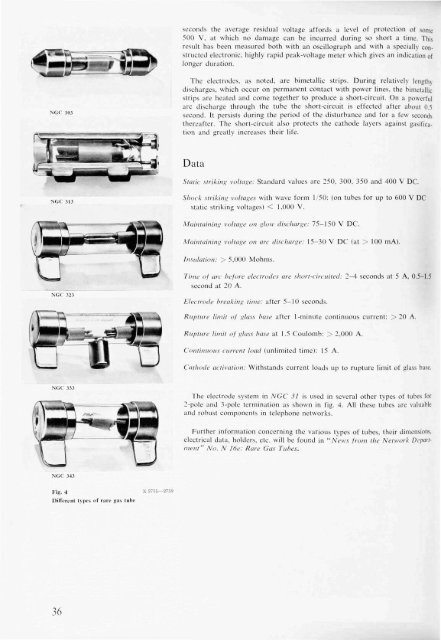1 - History of Ericsson - History of Ericsson
1 - History of Ericsson - History of Ericsson
1 - History of Ericsson - History of Ericsson
Create successful ePaper yourself
Turn your PDF publications into a flip-book with our unique Google optimized e-Paper software.
NGC 303<br />
NGC 313<br />
NGC 323<br />
NGC 343<br />
Fig. 4 X 2755—2759<br />
Different types <strong>of</strong> rare gas tube<br />
36<br />
seconds the average residual voltage affords a level <strong>of</strong> protection <strong>of</strong> some<br />
500 V, at which no damage can be incurred during so short a time. This<br />
result has been measured both with an oscillograph and with a specially constructed<br />
electronic, highly rapid peak-voltage meter which gives an indication <strong>of</strong><br />
longer duration.<br />
The electrodes, as noted, are bimetallic strips. During relatively lengthy<br />
discharges, which occur on permanent contact with power lines, the bimetallic<br />
strips are heated and come together to produce a short-circuit. On a powerful<br />
arc discharge through the tube the short-circuit is effected after about 0.5<br />
second. It persists during the period <strong>of</strong> the disturbance and for a few seconds<br />
thereafter. The short-circuit also protects the cathode layers against gasification<br />
and greatly increases their life.<br />
Data<br />
Static striking voltage: Standard values are 250. 300, 350 and 400 V DC.<br />
Shock striking voltages with wave form 1/50: (on tubes for up to 600 V DC<br />
static striking voltages) < 1,000 V.<br />
Maintaining voltage on glow discharge: 75-150 V DC.<br />
Maintaining voltage on arc discharge: 15-30 V DC (at > 100 mA).<br />
Insulation: > 5,000 Mohms.<br />
Time <strong>of</strong> arc hejore electrodes are short-circuited: 2-4 seconds at 5 A, 0.5-1.5<br />
second at 20 A.<br />
Electrode breaking time: after 5-10 seconds.<br />
Rupture limit <strong>of</strong> glass base after 1-minute continuous current: > 20 A.<br />
Rupture limit <strong>of</strong> glass base at 1.5 Coulomb: > 2,000 A.<br />
Continuous current load (unlimited time): 15 A.<br />
Cathode activation: Withstands current loads up to rupture limit <strong>of</strong> glass base.<br />
The electrode system in NGC 31 is used in several other types <strong>of</strong> tubes for<br />
2-pole and 3-pole termination as shown in fig. 4. All these tubes are valuable<br />
and robust components in telephone networks.<br />
Further information concerning the various types <strong>of</strong> tubes, their dimensions,<br />
electrical data, holders, etc. will be found in "News from the Network Department"<br />
No. N 16e: Rare Gas Tubes.
















